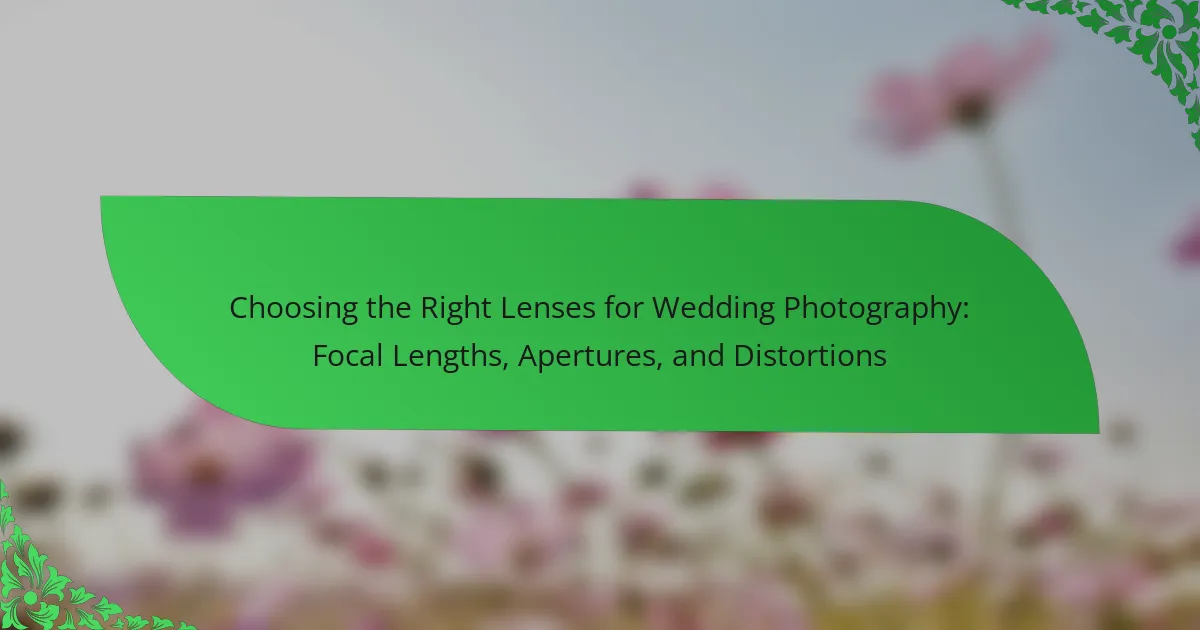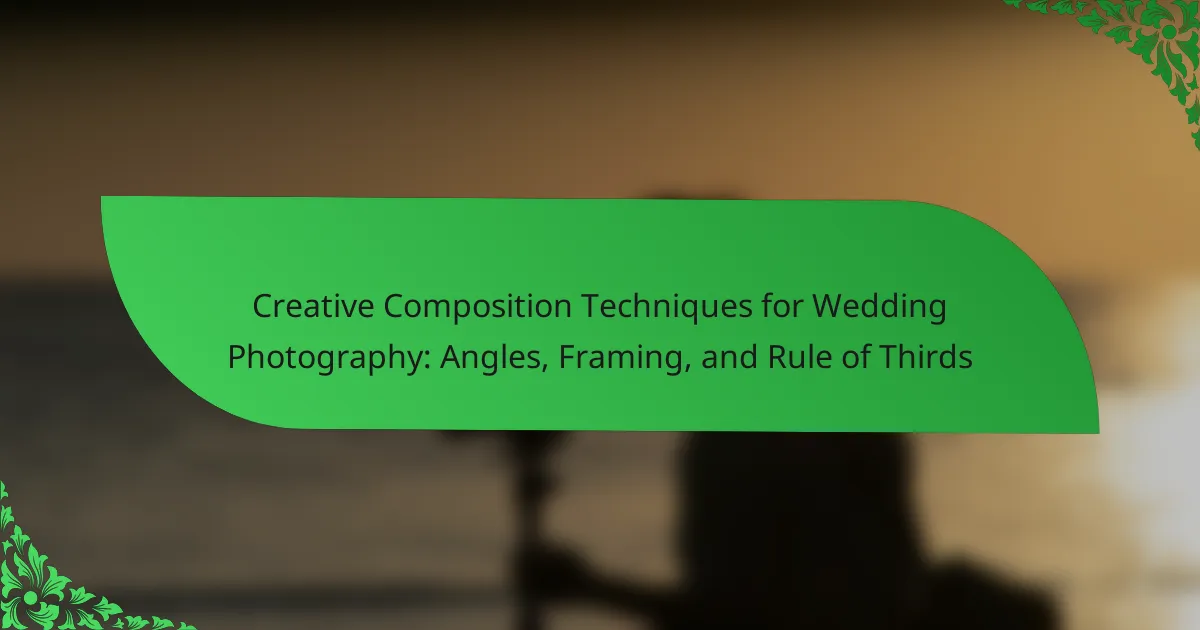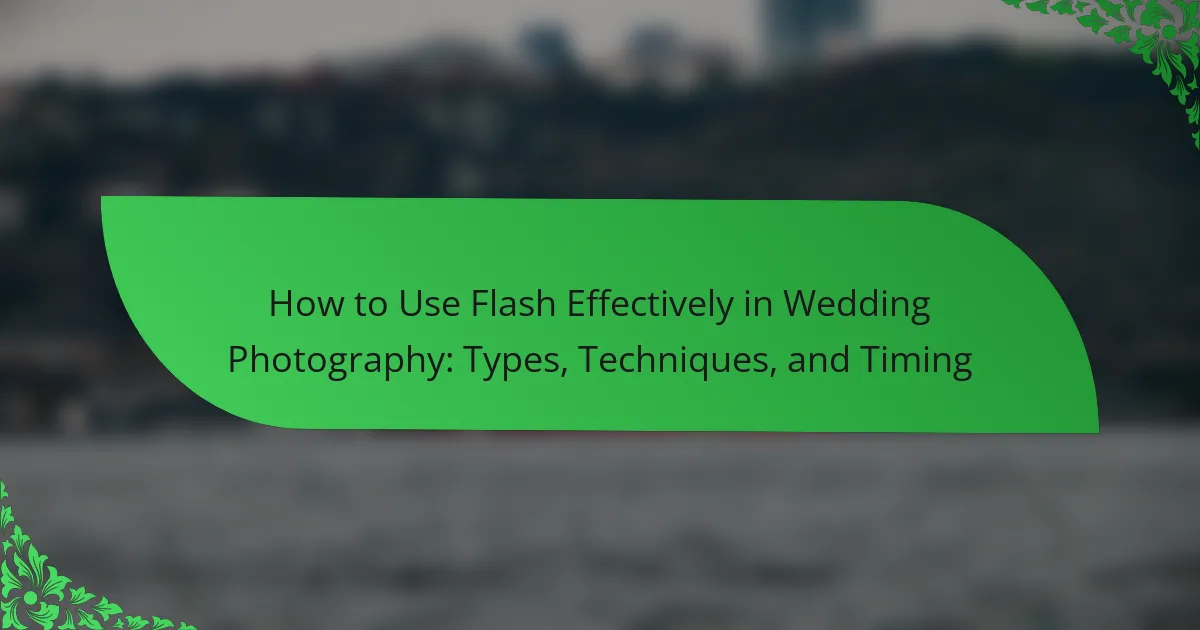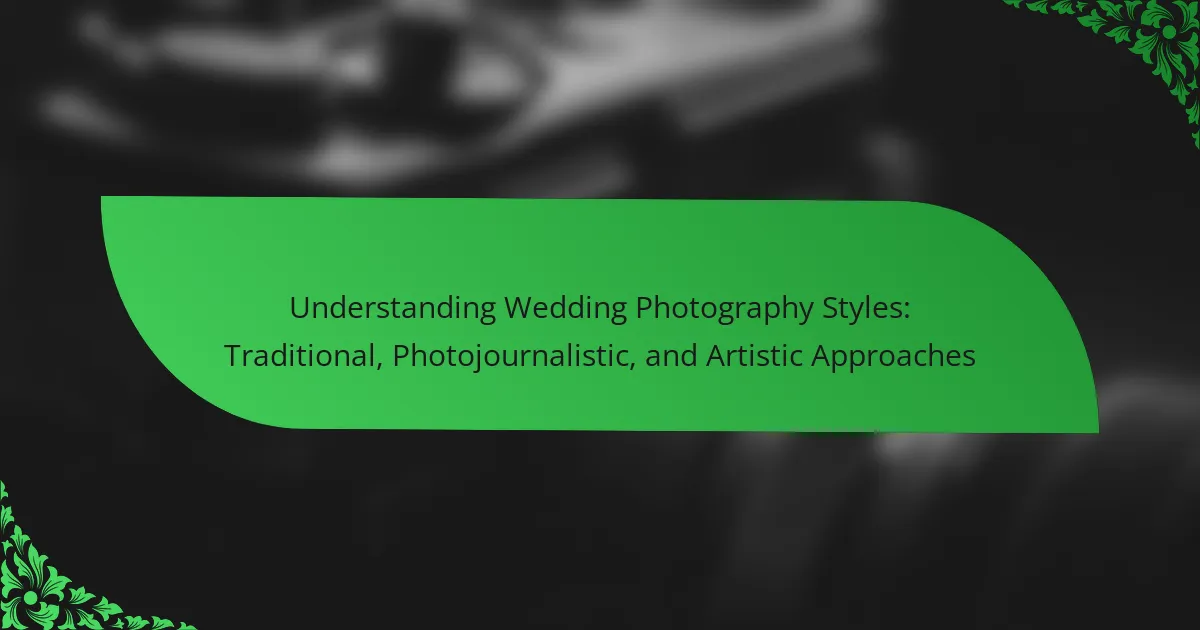Choosing the right lenses for wedding photography involves understanding key factors such as focal length, aperture, and distortion. Focal length influences composition, with versatile options like the 24-70mm zoom lens and sharp prime lenses like the 50mm being essential for various shots. Wide apertures, such as f/1.8, enhance low-light performance and create appealing depth of field. Minimizing distortion is crucial for maintaining image quality, particularly in portraits and group shots, with specific focal lengths helping to reduce these effects. This article provides insights into the best types of lenses, including prime, zoom, and macro lenses, and offers strategies for managing distortion in wedding photography effectively.
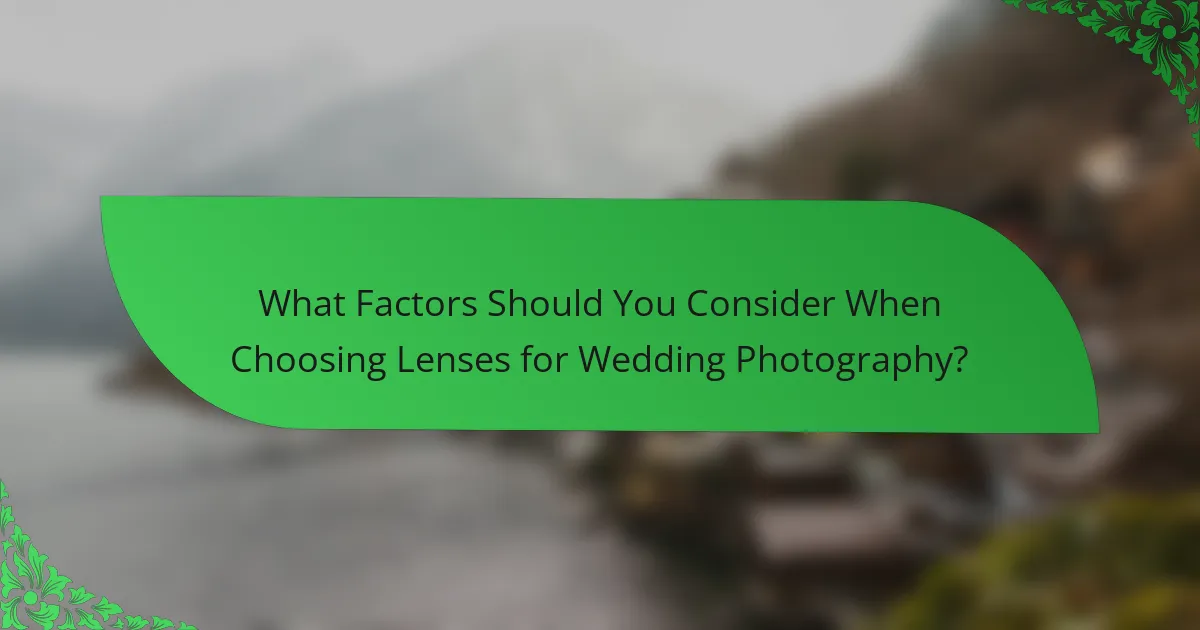
What Factors Should You Consider When Choosing Lenses for Wedding Photography?
When choosing lenses for wedding photography, consider focal length, aperture, and distortion. Focal length affects composition and perspective. A 24-70mm lens is versatile for capturing wide shots and portraits. A prime lens, like a 50mm, offers sharpness and a shallow depth of field. Aperture influences light intake and depth of field. A lens with a wide aperture, such as f/1.8, allows for better low-light performance. Distortion can impact image quality. Lenses with minimal distortion are preferable for portraits and group shots. These factors collectively enhance the quality and creativity of wedding photography.
How do focal lengths impact your wedding photography?
Focal lengths significantly impact wedding photography by affecting composition and perspective. Different focal lengths create varied visual effects. For instance, wide-angle lenses (e.g., 24mm) capture more of the scene, ideal for group shots and venue details. Telephoto lenses (e.g., 85mm) compress space, making subjects appear closer together, which is perfect for portraits.
Additionally, focal lengths influence depth of field. Shorter focal lengths yield a greater depth of field, keeping more elements in focus. In contrast, longer focal lengths produce a shallower depth of field, allowing for beautiful background blur, emphasizing the subject.
The choice of focal length also affects the photographer’s distance from the subject. Wide-angle lenses allow closer shots without distortion, while telephoto lenses require more distance, affecting interactions.
Understanding these effects helps photographers select the right lens for specific moments during weddings, enhancing storytelling through imagery.
What are the different focal lengths available for wedding lenses?
Wedding lenses typically come in various focal lengths, including wide-angle, standard, and telephoto. Common wide-angle lenses range from 16mm to 35mm. These lenses are ideal for capturing expansive scenes and group shots. Standard lenses usually fall between 35mm and 70mm. They provide a natural perspective for portraits. Telephoto lenses generally range from 70mm to 200mm or more. These lenses excel in capturing details from a distance and isolating subjects. Each focal length serves a specific purpose in wedding photography, allowing photographers to choose based on their creative needs.
How does focal length affect composition in wedding photography?
Focal length significantly affects composition in wedding photography by influencing perspective and framing. Shorter focal lengths, such as 24mm, capture wider scenes and include more background elements. This is useful for group shots and venue details. Longer focal lengths, like 85mm or 135mm, create tighter compositions, emphasizing subjects and isolating them from the background. This enhances portraits by providing a pleasing bokeh effect. The choice of focal length also affects depth of field. A longer focal length compresses space, making subjects appear closer together. In contrast, shorter focal lengths can create a sense of depth and distance. Ultimately, understanding focal length is essential for achieving desired artistic effects in wedding photography.
Why is aperture important in wedding photography?
Aperture is important in wedding photography because it controls the amount of light entering the camera. This directly affects exposure and depth of field. A wider aperture (lower f-stop number) allows more light, which is beneficial in low-light situations, such as indoor venues. This helps capture sharp images without using high ISO settings that can introduce noise. Additionally, a wider aperture creates a shallow depth of field. This effect beautifully blurs the background, making subjects stand out. Conversely, a smaller aperture (higher f-stop number) increases depth of field. This is useful for group shots where more of the scene needs to be in focus. Mastering aperture settings enhances the creative control photographers have over their images.
What is the relationship between aperture and depth of field?
Aperture directly influences depth of field in photography. A larger aperture (smaller f-stop number) results in a shallower depth of field. This effect creates a blurred background, emphasizing the subject. Conversely, a smaller aperture (larger f-stop number) increases the depth of field. This allows more of the scene to be in focus. The relationship is crucial for controlling focus in wedding photography. Photographers often adjust aperture to achieve desired artistic effects. Studies show that aperture settings significantly affect perceived sharpness and focus in images.
How does aperture influence low-light performance in wedding settings?
Aperture significantly influences low-light performance in wedding settings. A wider aperture, indicated by a lower f-stop number, allows more light to enter the lens. This increased light improves the camera’s ability to capture images in dimly lit environments. For example, an aperture of f/1.8 lets in more light than f/4.0. This capability is crucial during evening receptions or indoor ceremonies where lighting may be limited. Additionally, wider apertures create a shallower depth of field. This effect can enhance the subject’s focus while softly blurring the background. Ultimately, using a lens with a wider aperture can lead to better exposure and sharper images in low-light wedding scenarios.
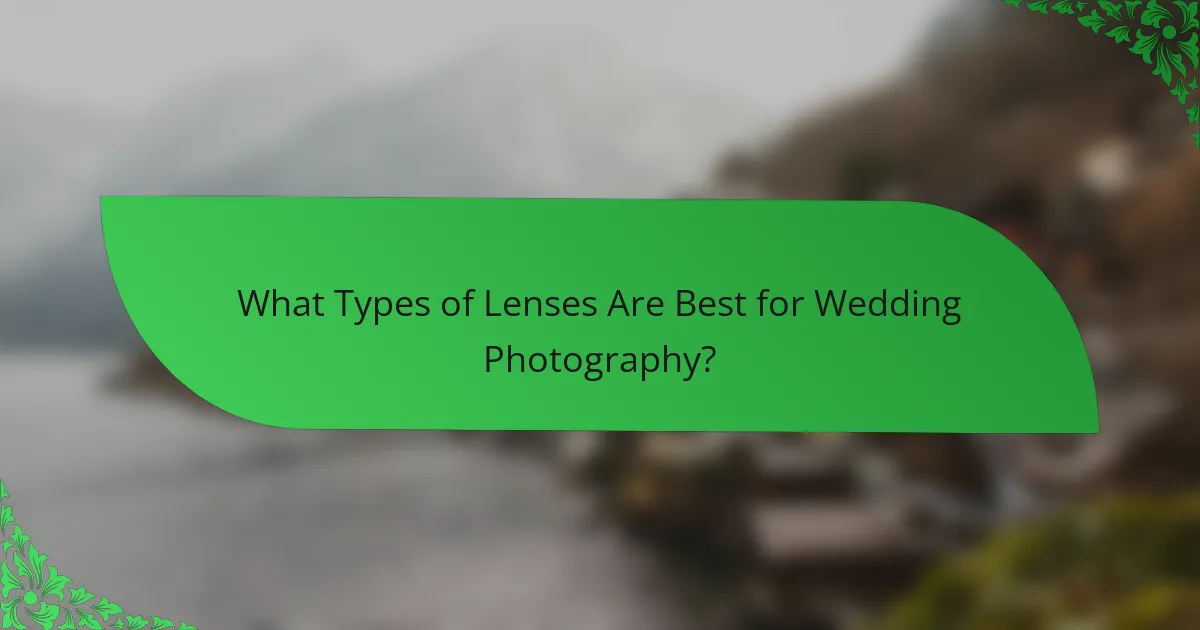
What Types of Lenses Are Best for Wedding Photography?
The best types of lenses for wedding photography include prime lenses, zoom lenses, and macro lenses. Prime lenses, such as 50mm and 85mm, offer wide apertures for low-light conditions and beautiful bokeh. Zoom lenses, like 24-70mm and 70-200mm, provide versatility for capturing various scenes without changing lenses. Macro lenses are ideal for close-up shots of details, such as rings and decorations. These lenses cover essential focal lengths and apertures needed for diverse wedding scenarios. Their unique attributes enhance image quality and artistic expression, crucial in wedding photography.
What are the advantages of prime lenses in wedding photography?
Prime lenses offer several advantages in wedding photography. They typically have larger maximum apertures. This allows for better low-light performance. Prime lenses often produce sharper images compared to zoom lenses. Their optical design usually minimizes distortion and aberrations.
Photographers can achieve a more pronounced depth of field with prime lenses. This helps in creating beautiful background blur, enhancing the subject. Additionally, prime lenses are generally lighter and more compact. This makes them easier to carry during long wedding days.
Using prime lenses can also encourage photographers to be more intentional with their compositions. They require more movement and positioning, leading to creative framing. Overall, prime lenses are a favored choice for capturing high-quality wedding photographs.
How do prime lenses differ from zoom lenses for wedding shoots?
Prime lenses have a fixed focal length, while zoom lenses offer variable focal lengths. This means prime lenses require physical movement to change composition. They generally provide wider apertures, allowing for better low-light performance and shallower depth of field. This is advantageous for capturing portraits and details at weddings. Zoom lenses, however, offer versatility and convenience by covering multiple focal lengths in one lens. This can be beneficial for dynamic wedding environments where subjects are constantly moving. Prime lenses typically produce sharper images due to fewer glass elements. Conversely, zoom lenses may introduce distortion at extreme focal lengths. Ultimately, the choice depends on the photographer’s style and the specific wedding scenarios.
What specific prime lenses are recommended for wedding photography?
Recommended prime lenses for wedding photography include the Canon EF 50mm f/1.2L, Nikon AF-S 50mm f/1.4G, and Sony FE 50mm f/1.8. The Canon EF 85mm f/1.2L is also favored for its beautiful bokeh. The Nikon AF-S 85mm f/1.8G provides sharp images and excellent low-light performance. The Sigma 35mm f/1.4 DG HSM Art lens is praised for its versatility and image quality. Each lens offers unique attributes suited for capturing moments at weddings. These lenses are commonly used by professional photographers for their speed and image clarity.
What role do zoom lenses play in capturing wedding moments?
Zoom lenses provide versatility in capturing wedding moments. They allow photographers to adjust focal lengths quickly. This adaptability is crucial during dynamic wedding events. Photographers can switch between wide shots and close-ups seamlessly. Zoom lenses also reduce the need for changing lenses frequently. This minimizes the risk of missing important moments. Additionally, they can create varying perspectives and compositions. The ability to zoom in helps capture intimate details, like rings or expressions. Overall, zoom lenses enhance the storytelling aspect of wedding photography.
What are the benefits of using a zoom lens for flexibility during weddings?
Using a zoom lens provides significant flexibility during weddings. It allows photographers to quickly adjust focal lengths without changing lenses. This adaptability is crucial in dynamic environments like weddings. Photographers can capture intimate moments from a distance or switch to wide-angle shots for group photos. Zoom lenses also reduce the risk of missing key moments. They enable seamless transitions between different scenes and subjects. Additionally, they minimize the need to carry multiple lenses, enhancing mobility. Overall, a zoom lens is an essential tool for effective wedding photography.
Which zoom lenses are ideal for various wedding scenarios?
The ideal zoom lenses for various wedding scenarios include the 24-70mm f/2.8 and the 70-200mm f/2.8. The 24-70mm f/2.8 is versatile for capturing wide shots and close-ups. It performs well in diverse lighting conditions, making it suitable for ceremonies and receptions. The 70-200mm f/2.8 is excellent for portraits and candid moments from a distance. Its compression creates flattering images of the couple and guests. Both lenses have a constant aperture, allowing for consistent exposure. These lenses are popular among wedding photographers for their quality and flexibility.
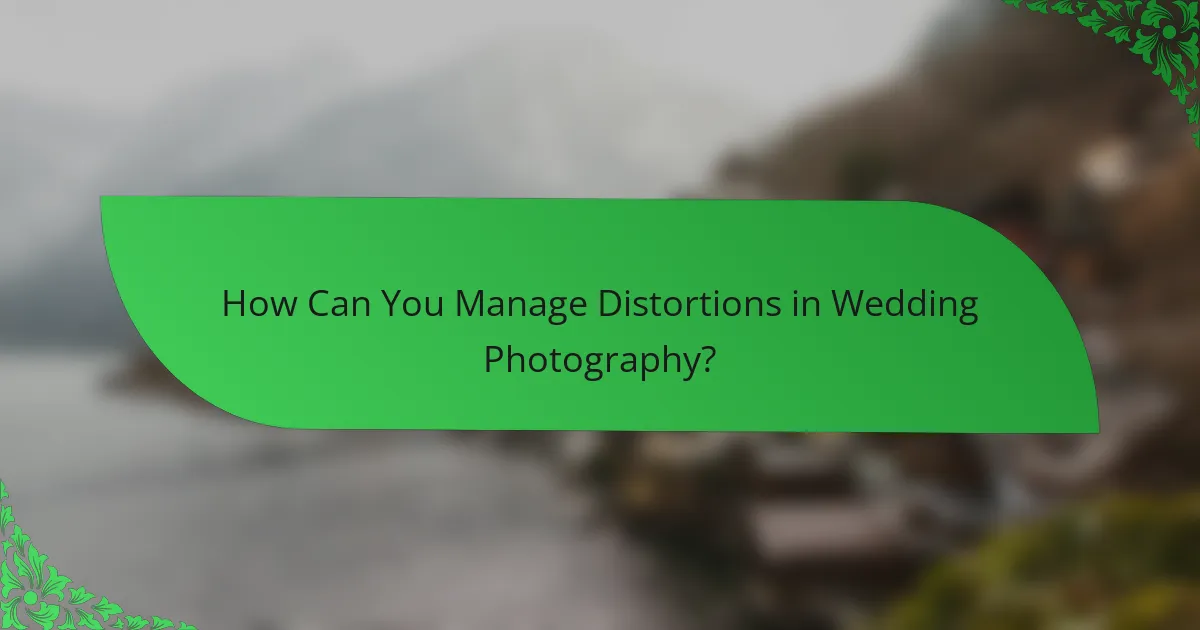
How Can You Manage Distortions in Wedding Photography?
To manage distortions in wedding photography, use lenses with minimal distortion characteristics. Wide-angle lenses often introduce distortions like barrel distortion. Choosing a lens with a focal length between 24mm and 35mm can reduce these effects. Additionally, using post-processing software can correct distortions after the shoot. Programs like Adobe Lightroom and Photoshop offer tools specifically for lens correction. Proper framing and distance from subjects can also minimize distortion. For example, shooting from a slight distance rather than up close helps maintain proportions. Overall, selecting the right lens and utilizing software are effective strategies for managing distortions in wedding photography.
What types of distortions can occur with wedding lenses?
Wedding lenses can experience several types of distortions. Common distortions include barrel distortion, which causes straight lines to curve outward. This is often noticeable in wide-angle lenses. Pincushion distortion is another type, where straight lines curve inward. This distortion typically occurs with telephoto lenses. Additionally, chromatic aberration can happen, leading to color fringing around edges. This effect is due to different wavelengths of light being focused at different points. Lastly, vignetting may occur, resulting in darker corners of the image. This can be more pronounced at wider apertures. Each of these distortions can impact the overall quality of wedding photographs.
How can barrel distortion affect wedding photos?
Barrel distortion can significantly affect wedding photos by causing straight lines to appear curved. This distortion is commonly seen in wide-angle lenses. It can lead to unflattering images, particularly in group photos or architectural shots. The curvature can distract from the subjects and alter the composition. For example, subjects near the edges may look stretched or distorted. This can result in an unnatural appearance in the final images. Photographers often need to correct barrel distortion in post-processing to restore image integrity. However, excessive correction can lead to loss of detail. Choosing the right lens can minimize this distortion from the outset.
What are the solutions to minimize distortions in wedding photography?
Use prime lenses to minimize distortions in wedding photography. Prime lenses typically have fewer glass elements. This design reduces optical aberrations. Choose wide-angle lenses carefully. They can introduce barrel distortion. Use lens correction software during editing. This can effectively correct distortions post-shoot. Maintain proper distance from subjects. This helps avoid perspective distortion. Utilize a tripod for stability. It ensures consistent framing and reduces shake.
How can you correct distortions in post-processing?
To correct distortions in post-processing, use software tools designed for lens correction. Programs like Adobe Lightroom and Photoshop offer specific features for this purpose. These tools can adjust barrel or pincushion distortions effectively. Users can apply lens profiles that automatically correct known distortion types. Manual adjustments can also be made using sliders for distortion control. Additionally, cropping the image may help eliminate unwanted distortion effects. Regularly calibrating your lens can also improve accuracy in corrections. This process enhances overall image quality in wedding photography.
What software tools are effective for distortion correction?
Adobe Lightroom is an effective software tool for distortion correction. It provides lens correction profiles that automatically adjust image distortion based on the lens used. Capture One also offers robust distortion correction features with customizable adjustments. DxO PhotoLab includes advanced algorithms for correcting lens distortion and perspective issues. Additionally, Photoshop has a dedicated lens correction filter that allows manual adjustments. These tools are widely recognized for their effectiveness in correcting various types of distortion in photography.
What techniques should you use to ensure minimal distortion in-camera?
Use prime lenses to minimize distortion in-camera. Prime lenses typically have fewer glass elements than zoom lenses. This design reduces optical aberrations, leading to sharper images. Additionally, choose a focal length that fits the scene without excessive cropping. Wide-angle lenses can introduce distortion, especially at the edges. Maintain proper distance from subjects to avoid perspective distortion. Use a tripod to stabilize the camera for sharper images. Lastly, shoot at the lens’s optimal aperture, often between f/8 and f/11, to enhance image quality. These techniques collectively help achieve minimal distortion in your photographs.
What are some practical tips for selecting the right lenses for wedding photography?
Select lenses based on focal length for wedding photography. A 24-70mm lens is versatile for various shots. Use a 70-200mm lens for capturing candid moments from a distance. Consider a prime lens, like a 50mm or 85mm, for portraits with beautiful bokeh. Aperture is crucial; choose lenses with wide apertures, such as f/1.8 or f/2.8, for low-light conditions. This helps achieve a shallow depth of field. Test lenses for distortion; wide-angle lenses can create unwanted effects. Ensure you have a mix of lenses for different scenarios during the wedding day. Having backup options is also advisable to avoid missing key moments.
The main entity of this article is lenses for wedding photography. Key factors to consider when selecting lenses include focal length, aperture, and distortion, which collectively impact composition, light intake, and image quality. The article outlines various focal lengths available, the importance of aperture for low-light performance, and how to manage distortions. It also discusses the advantages of prime versus zoom lenses, as well as practical tips for choosing the right lenses to enhance wedding photography outcomes.
